Mars Statistics By Size, Orbit Duration and Missions

Updated · Dec 01, 2025


WHAT WE HAVE ON THIS PAGE
- Introduction
- Editor’s Choice
- Facts About Mars
- General Mars Statistics
- Mars Orbit Duration Statistics
- Mars’s Orbit and Rotation Statistics
- Mars’s Structure and Surface Statistics
- Mars vs Earth Research Statistics
- Missions to Mars
- Mars Atmosphere Magnetosphere and Moon Status
- Mars Meteorite Craters Statistics
- Chemical Elements on Mars
- Conclusion
Introduction
Mars Statistics: Mars, often referred to as the “Red Planet,” is the fourth planet from the Sun and stands out due to its distinctive reddish hue, resulting from iron oxide prevalent on its surface. With a diameter of approximately 6,792 kilometers, Mars is about half the size of Earth. Its mass is roughly 0.64169 × 10²⁴ kilograms, equating to about 11% of Earth’s mass. The planet’s surface gravity is approximately 3.73 meters per second squared, which is 38% of Earth’s gravity. Mars completes an orbit around the Sun in 687 Earth days, defining its year length. A single rotation on its axis, known as a sol, lasts about 24.6 hours, closely mirroring Earth’s day length.
The planet’s axial tilt of 25 degrees results in seasonal variations similar to those on Earth. Surface temperatures on Mars can range from approximately -153 degrees Celsius to 20 degrees Celsius, reflecting its thin atmosphere and greater distance from the Sun. Mars hosts the tallest volcano in the solar system, Olympus Mons, which stands about 25.75 kilometers high, over three times the height of Mount Everest.
Additionally, Mars has two small moons, Phobos and Deimos, which are believed to be captured asteroids. These characteristics make Mars a focal point for scientific exploration and the search for past or present life forms.
Editor’s Choice
- Mars has around 43,000 craters from the LHB, with the largest being the Hellas impact basin.
- Mars’s pivotal tilt is almost 25 degrees, which is very similar to Earth’s, causing it to have similar seasonal changes over its longer years.
- The major chemical elements of Mars’s surface are 43% oxygen, 5.5% Magnesium, 5.6% Aluminium, 23% Silicon, and 14% Iron.
- Spacecraft have extensively mapped Mars, revealing detailed features of its surface. Nearly the entire planet has been photographed from orbit with a resolution of 20 meters (66 feet), and some areas have been captured at resolutions as fine as 20 centimeters (8 inches).
- The 34 Martian meteorites cataloged by NASA are highly prized assets. Their rarity and the unique information they provide about Mars make them extremely valuable.
- Mars has a diameter (distance from the center) of almost 6.791 kilometers, and it is roughly 50% of the Earth’s size.
- Mars is more likely to be struck by asteroid belt debris and short-period comets, but due to its atmosphere, it has fewer craters than the Moon.
- Mariner 9 covered 85% of the Martian surface and also shared more than 7,000 images with Earth.
- Mars is more likely to be hit by short-period comets that orbit within Jupiter’s path. Despite this, Mars has fewer craters than the Moon. This is because Mars’ atmosphere protects it from smaller meteors.
- NASA has a catalog of 34 meteorites from Mars, which are highly valuable.
- Mars’s temperature can reach as high as 70 degrees F/ 20 degrees C and as low as -225 degrees F/ -153 degrees Celsius.
- Some meteorites contain structures that might indicate past life, although the exact cause is still unknown.
- Mars does not have a ring, as it is thought that in almost 50 million years, Phobos will either break or crash into Mars.
- These meteorites are of significant scientific and commercial interest, with potential implications for space research and exploration.
- China successfully landed its first rover, ‘Zhurong,‘ which was part of the Tianwen 1 mission in 2021.
- This northern hemisphere impact crater measures about 8,500 by 10,700 km (5,300 by 6,600 miles), with the impacting object estimated to be over 2,000 km (1,200 miles) across.
- The Martian days are known as sols, short for the “solar day.” One year on Mars lasts 669.6 sols, which is the same as 687 Earth days.
Facts About Mars
- The Red Planet: Mars is famously known as the “Red Planet” due to its reddish appearance, which is caused by a large amount of iron oxide in its rocks and soil.
- Roman God of War: Mars is named after the Roman god of war and is the fourth planet from the Sun in our solar system.
- Size: Mars is the second smallest planet in the solar system, after Mercury.
- Diameter: Mars has a diameter of approximately 6,791 kilometers, making it roughly 50% the size of Earth.
- Temperature: Mars is much farther from the Sun than Earth, resulting in a colder climate. Temperatures can reach up to 20°C at the equator but can drop as low as -140°C at the poles.
- Olympus Mons: Mars is home to the highest mountain in our solar system, Olympus Mons, a volcano that stands 24 kilometers high, about three times taller than Mount Everest.
- Gravity: Mars’ gravity is weaker than Earth’s, allowing you to jump around three times higher.
- Day Length: A day on Mars is about 24 hours and 37 minutes, only slightly longer than a day on Earth.
- Year Length: A year on Mars lasts about 687 Earth days, nearly twice as long as a year on Earth.
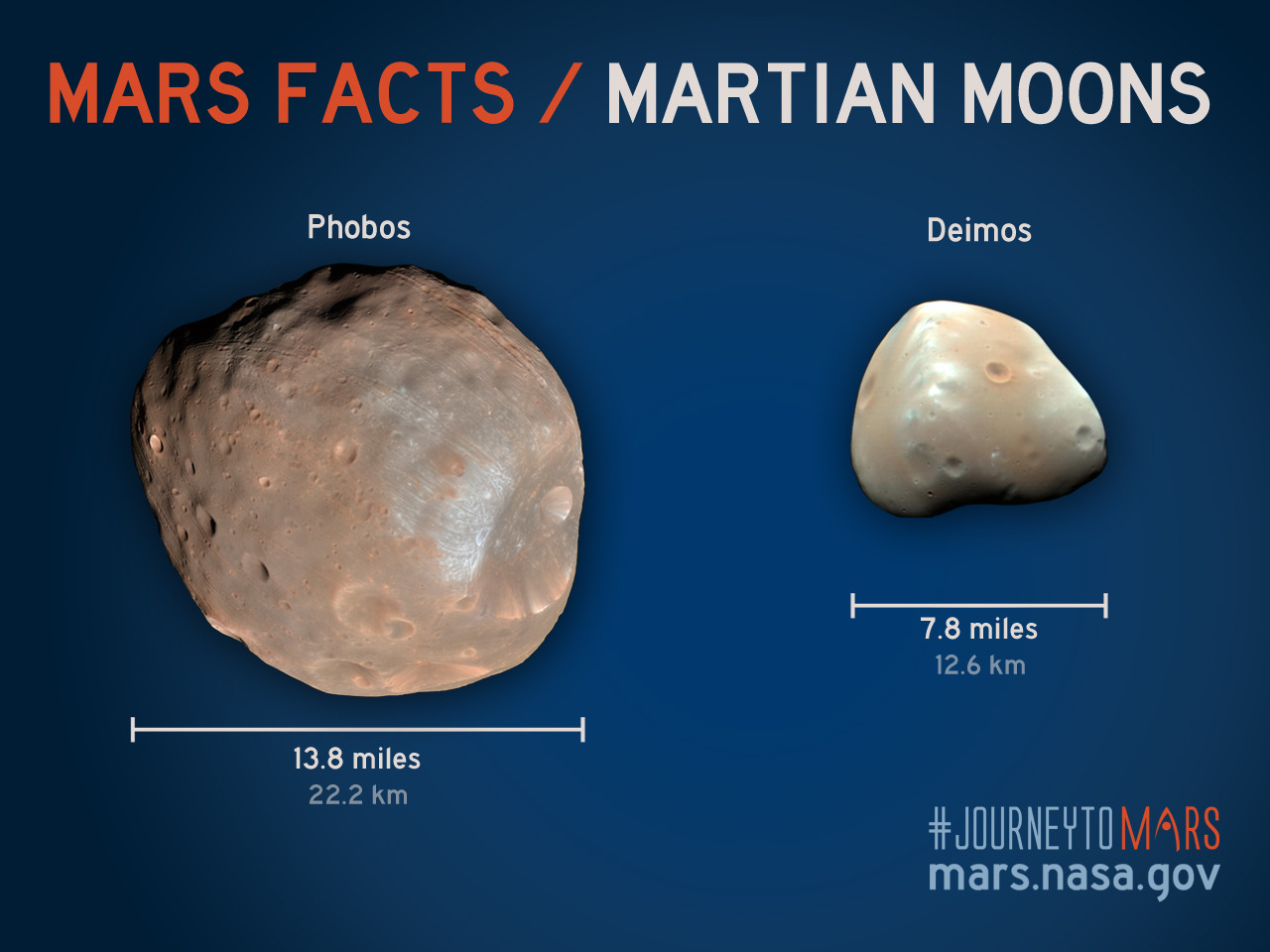
(Source: nasa.tumblr.com)
- According to Mars statistics, Mars has two moons, namely Phobos and Deimos.
- Human beings have yet to reach Mars, but scientists from around the world have sent spacecraft there to help them so research on this fascinating planet.
- The first spacecraft to land on Mars was the Viking Lander, which touched down on the surface of Mars in 1976.
General Mars Statistics
- The Red Planet is almost 4,212.3 miles in diameter, which makes it almost 50% of the size of the Earth.
- Mars has a hot climate, but the temperatures vary drastically and are often freezing. In the median, they are almost -85°F, with temperatures reaching 69.8°F in summer and plunging to -243°F closer to the Poles.
- Mars is farther from the Sun than Earth, and its atmosphere is almost 100 times thinner than Earth’s, which means it cannot hold onto heat energy.
- On average, it would take almost seven months to reach Mars from Earth if traveling at almost 24,855 miles every hour.
- Mars can be seen from Earth; it is about 140 million miles away.
- Mars is believed to have been formed about 4.6 billion years ago from a big spinning disk of gas and dust.
- As per Mars Statistics, NASA is sending robots to explore more details of Mars. To date, five robotics vehicles known as “rovers” have been sent to Mars and are used to explore the landscape, take photos, and collect data for scientists to study.
- Mars has extinct volcanoes, canyons, polar ice, seasons, and even changing weather similar to Earth’s.
- The biggest canyon on Mars is Valles Marineris, which stretches more than 2,500 miles and is 11 times longer than the Grand Canyon.
- It can be found as icy dirt below the surface in the Polar regions and traces of salty liquid water on hillsides. There are signs of river networks, lakes, and deltas, and indications of huge floods from 3.5 billion years ago.
- According to statistics, Mars is so windy that dust storms can cover almost the whole planet, and these winds are so strong that it can take months for the dust to settle.
- Mars has the biggest volcano in the solar system, Olympus Mons, which stands an enormous 16 miles high, three times bigger than Mt. Everest.
- Mars is 147 million miles from the Sun, so sunlight can take 13 minutes to reach it.
- There is almost 60% less gravity on Mars than on Earth. If we try to walk on Mars, it will be very bouncy.
- According to the statistics, astronauts are planning to travel to Mars in 2030, the farthest humans have traveled from Earth since the Apollo 17 mission to the moon.
Mars Orbit Duration Statistics
- According to Gitnux statistics, the Earth’s orbit radius around the Sun is approximately 142 million miles or 228 million kilometers.
- Mars’ highest time of apparent retrograde motion is created by Earth “overtaking” Mars in their orbits on an average of 72 days.
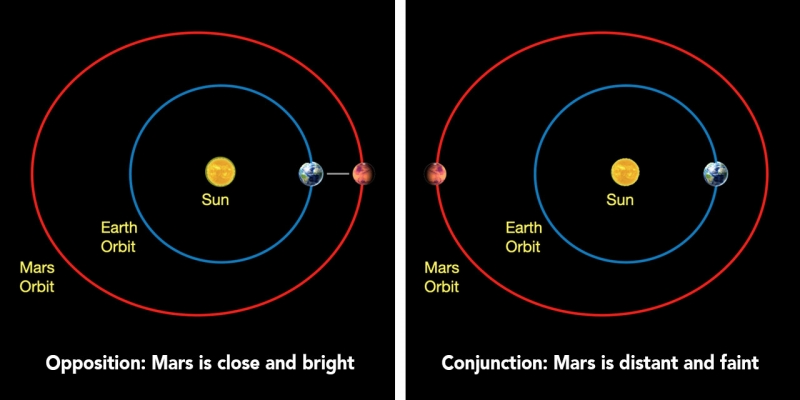
(Source: letstalkscience.ca)
- Mars’s pivotal tilt is almost 25 degrees, which is very similar to Earth’s, causing it to have similar seasonal changes over its longer years.
- Mars’ orbit around the Sun is more concise than Earth’s, which means it travels more slowly when it is further from the Sun and faster when it is closer.
- Mars’s revolving is nearly similar to Earth’s, completing one rotation in only 24 hours. This is partially compensation for the longer duration of its year, with irregular day and night cycles throughout the year.
- Mars delivers perihelion once every Mars year, at the same point in its orbit.
- The median distance from the Sun to Mars is around 228 million kilometers.
- Mars’s orbit is more ellipsoidal or oval-shaped than Earth’s, which affects the planet’s gap from the Sun and, thus, its atmosphere.
- Mars orbits farther from the Sun than the Earth. Therefore, sunlight reaching Mars is less than half as acute as it is on Earth.
- Despite Mars’s long year, its day is the same as Earth’s, which is only about 40 minutes long.
- The further distance from the Sun (aphelion) is almost 249 million kilometers.
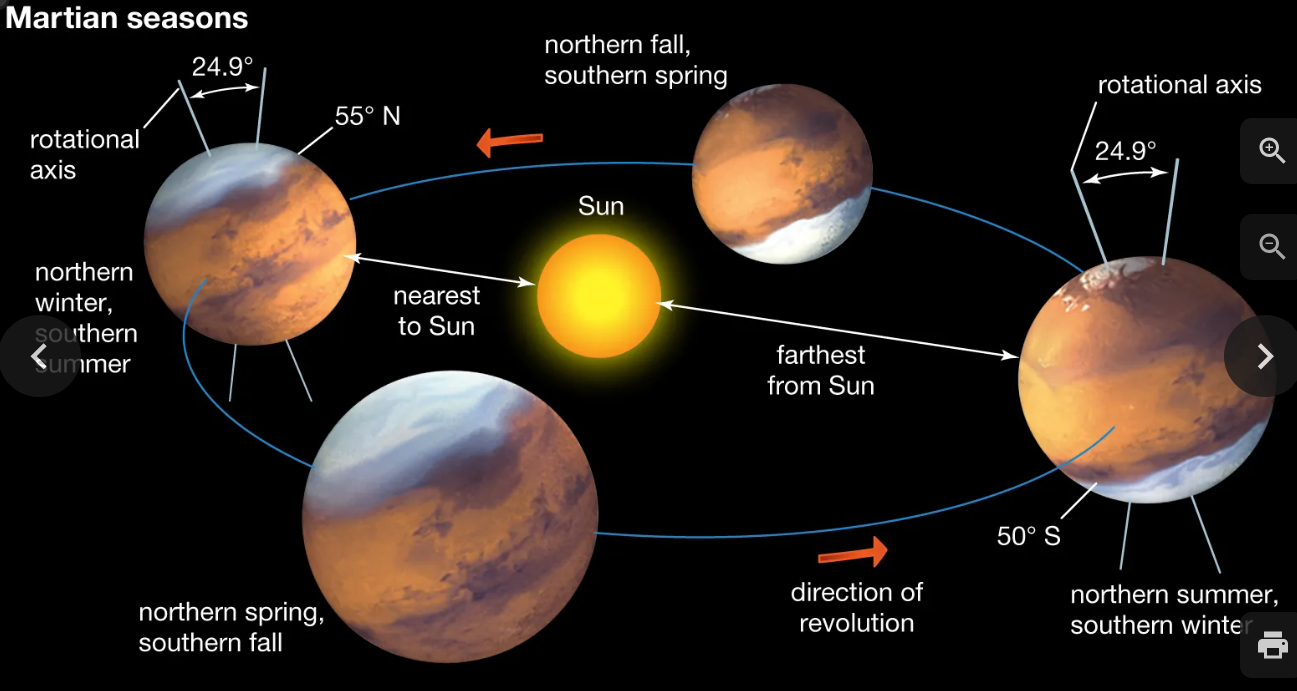
(Source: britannica.com)
- Mars’s perihelion is around 207 million kilometers.
- As a result of its prolonged orbit, Mars had a bigger distance variation from the Sun than Earth.
- The peculiarity of Mars’ orbit around the Sun is almost 0.093.
- Mars has an orbital inclination of 1.85 degrees that’s relative to the ecliptic.
- One year on Mars equals 1.8809 Earth years because of the length of its orbital duration.
- Mars’s orbit is more oval than Earth’s, and it causes temperature and environmental variations.
- In orbit of Mars, the planet has a median speed of 24 kilometers every second.
- Mars’ orbit around the Sun takes almost 687 Earth days, according to Mars statistics.
Mars’s Orbit and Rotation Statistics
- As Mars revolves around the Sun, it finishes a single round every 24.6 hours, which is the same as one day on Earth, which is 23.9 hours.
- The Martian days are known as sols, short for the “solar day.” One year on Mars lasts 669.6 sols, which is the same as 687 Earth days.
- Mars’s axis of rotation is inclined at 25 degrees relative to the plane of its orbit around the Sun, similar to the Earth’s axial tilt of 23.4 degrees.
- Mars has various seasons, but they last longer than seasons on Earth because Mars takes longer to orbit the Sun.
- On Earth, the seasons have equally spread over the past years, lasting for three months, and on Mars, the seasons differ in length as Mars’s elliptical, oval-shaped orbit around the Sun.
- In the northern hemisphere, the long season is Spring, with 194 sols. Autumn is short, with 142 days.
Mars’s Structure and Surface Statistics
- Mars has a thick inner part at its center, between 930 and 1,300 miles.
- The structure of Mars is made of nickel, iron, and sulfur.
- Mars surrounds the core, which is a rocky cape between 770 and 1,170 miles dense. The crust is made up of calcium, potassium, iron, aluminum, and magnesium.
- The crust of Mars is between 6 and 30 miles deep, which is equal to 10 to 50 kilometers.
- This Martian canyon is 200 miles in length and 4.3 miles at its deepest point. It is ten times the size of Earth’s Grand Canyon.
- According to Mars statistics, the surface of Mars has many colors, such as tan, gold, and brown.
- The reason the color of Mars looks reddish is because of oxidation or rusting of the iron in the soil, dust, and rocks. The dust gets spilled up in the surroundings and, from a distance, makes the planet appear almost red.
- Although Mars is almost 50% the diameter of the Earth, its surface has almost the same area as the Earth’s dry land.
- Impact craters, crustal movement, volcanoes, and environmental conditions like dust storms have altered the landscape of Mars over several years, making some of the solar system’s most attractive topographical features.
- A big canyon system known as Valles Marineris extends more than 3,000 miles from California to New York.
- Mars is common to the biggest volcano in the solar system, Olympus Mons. It is thrice than Mt.Everest on Earth and has a base size of the state of New Mexico.
- A survey found that Mars had a lot of water, with old river valley connections, lakebeds, and deltas, as well as rocks and minerals on the surface that could have formed in liquid water.
- According to the statistics, Mars witnessed huge floods almost 3.5 billion years ago.
- There is water on Mars currently, but the Martian surrounding area is very thin for liquid water to subsite for a long time on the surface.
- To date, water is found on Mars in the form of water ice under the surface in the polar regions and salty water that seasonally flows from the hillsides and crater walls.
- Spacecraft have extensively mapped Mars, revealing detailed features of its surface. Nearly the entire planet has been photographed from orbit with a resolution of 20 meters (66 feet), and some areas have been captured at resolutions as fine as 20 centimeters (8 inches).
- The Mars Global Surveyor’s laser altimeter has measured the planet’s elevations, averaging over areas 300 meters (1,000 feet) wide with a vertical accuracy of 1 meter (3.3 feet).
- Mars Odyssey, launched in 2001, created a global map showing the distribution of epithermal (medium-energy) neutrons on the Martian surface. These neutrons, displaced by cosmic rays, help scientists locate hydrogen-rich areas, suggesting significant water ice deposits below the surface.

(Source: britannica.com)
- Various maps have been developed to illustrate Mars’s topography, geology, temperature, and mineral distributions.
- After the Mariner 9 mission, Mars’s prime meridian—similar to Earth’s Greenwich meridian—was defined through a small crater named Airy-0 within the larger Airy crater.
- Longitude on Mars increases to the west of this meridian. However, some scientists prefer a system where longitude increases to the east, leading to maps with both coordinate systems.
- Despite its smaller size, Mars has greater elevation differences compared to Earth. The lowest point on Mars, within the Hellas impact basin, is 8 km (5 miles) below the reference level.
- The highest point, Olympus Mons, a volcano, rises 21 km (13 miles) above the reference level. The elevation range on Mars is 29 km (18 miles), compared to Earth’s 20 km (12.4 miles) from the Mariana Trench to Mount Everest.
- Since Mars lacks oceans, its elevation reference level isn’t based on sea level. Initially, in the 1970s, it was defined as the elevation where atmospheric pressure is 6.1 millibars (0.006 of Earth’s sea-level pressure). Later, with more accurate data from the Mars Global Surveyor, Mars’s mean radius of 3,389.51 km (2,106.14 miles) was adopted as the reference.
- One of Mars’s most striking features is the contrast between its hemispheres. The southern hemisphere is high and heavily cratered, similar to the Moon’s highlands.
- The northern hemisphere is lower and has fewer craters. The average elevation difference between the hemispheres is about 6 km (3.7 miles).
- The boundary between these hemispheres isn’t parallel to the equator but follows a great circle inclined by about 30°. This boundary varies from broad and irregular to cliffs.
- The most eroded areas on Mars are found along this boundary. They feature outflow channels, collapsed regions known as chaotic terrain, and a mix of valleys and ridges called fretted terrain.
- The Tharsis Rise, a massive volcanic plateau, straddles this boundary in the western hemisphere. It spans 4,000 km (2,500 miles) across and rises 8 km (5 miles) above the reference level at its center. It towers 12 km (7.5 miles) above the northern plains and over 2 km (1.2 miles) above the southern highlands. The largest volcanoes on Mars are located on or near the Tharsis Rise.
- Unlike Earth, Mars lacks landforms resulting from plate tectonics, such as long mountain chains, oceanic trenches, or interconnected ridge systems.
- The distinct difference between the hemispheres likely formed from a massive asteroid impact early in Mars’s history.
- This northern hemisphere impact crater measures about 8,500 by 10,700 km (5,300 by 6,600 miles), with the impacting object estimated to be over 2,000 km (1,200 miles) across.
- Gravity data from the Mars Global Surveyor indicate that the Martian crust is significantly thicker in the southern highlands than in the northern plains.
Mars vs Earth Research Statistics
| Property | Earth | Mars |
| Diameter | 12,756 km | 6,792 km |
| Circumference | 40,075 km | 21,339 km |
| Surface area | 5.10 × 108 km2 (510,064,472 km2) |
1.44 × 108 km2 (144,371,391 km2) |
| Volume | 1.08 × 1012 km3 (1,083,206,916,846 km3) |
1.63 × 1011 km3 (163,115,609,799 km3) |
| Mass | 5.97 × 1024 kg | 6.42 × 1023 kg |
| Average Density | 5 514 kg/m3 | 3,933 kg/m3 |
| Surface Gravity | 9.81 m/s2 | 3.71 m/s2 |
| Minimum Temperature | -88 degree C | -140 degree C |
| Maximum Temperature | 58 degree C | 30 degree C |
| The closest Distance to the Sun(called perihelion) | 1.47 × 108 km (147,098,291 km) |
2.07 × 108 km (206,655,215 km) |
| The farthest Distance from the Sun (called aphelion) | 1.52 × 108 km (152,098,233 km) |
2.49 × 108 km (249,232,432 km) |
| Orbit Distance (total length of orbit) | 9.40 × 108 km (939,887,974 km) |
1.43 × 109 km (1,429,085,052 km) |
| Average Orbital Velocity | 107,218 km/h | 86,677 km/h |
| Day Length | 24 hours | 24 hours, 37 minutes |
| Year Length | 365.25 days | 687 earth days |
| Axial Tilt | 23.5 degree | 25.2 degree |
| Number Moons | 1 | 2 |
| Planetary Magnetic Field | Yes | No |
| Closest Distance to Earth | N/A | 55.6 × 106 km |
| Farthest Distance from Earth | N/A | 401 × 106 km |
Sizes, Masses, and Orbits
Earth:
- Radius: About 6,371 km (3,959 miles)
- Mass: 5.97 × 10²⁴ kg
- Volume: 1.08321 × 10¹² km³
- Surface Gravity: 9.8 m/s² (1 g)
- Orbit: Around 149.6 million km (93 million miles) from the Sun
- Orbital Period: 365.25 days
- Day Length: 24 hours
Mars:
- Radius: Approximately 3,396 km (2,110 miles) at the equator
- Mass: 6.4185 × 10²³ kg (about 15% of Earth’s)
- Volume: 1.6318 × 10¹¹ km³ (0.151 of Earth’s)
- Surface Gravity: 3.711 m/s² (0.376 g)
- Orbit: Ranges from 206.7 million km (1.38 AU) to 249.2 million km (1.67 AU) from the Sun
- Orbital Period: 686.971 days (1.88 Earth years)
- Day Length: About 24 hours and 40 minutes
Structure and Composition
Earth:
- Core: Solid inner core (radius ~1,220 km) and liquid outer core (radius ~3,400 km)
- Mantle: About 2,890 km thick, composed of silicate rocks rich in iron and magnesium
- Crust: Averages 40 km thick, composed of igneous rocks and granite.
Mars:
- Core: Radius ~1,794 km, composed mainly of iron, nickel, and 16-17% sulfur
- Mantle: 1,300-1,800 km thick, silicate rocks with convection currents
- Crust: Averages 50 km thick, up to 125 km in some areas.
Surface Features
Earth:
- Water Coverage: About 70% of the surface
- Landforms: Mountains, volcanoes, trenches, canyons, plateaus, plains, and deserts.
Mars:
- Surface: Dry and dusty with iron oxide (rust), giving it a reddish color
- Water: Ice at the poles and beneath the surface, past evidence of liquid water
- Landforms: Olympus Mons (largest volcano), Valles Marineris (deepest canyon), sandy plains, large sand dunes, and impact craters.
Atmosphere and Temperature
Earth:
- Atmosphere: Dense, with 78% nitrogen and 21% oxygen
- Temperature: Average 14°C (57°F); extremes range from 70.7°C (159°F) to -89.2°C (-129°F)
Mars:
- Atmosphere: Thin, 96% carbon dioxide, 1.93% argon, 1.89% nitrogen
- Temperature: Average -46°C (-51°F); extremes from -143°C (-225°F) in winter to 35°C (95°F) in summer at the equator.
Magnetic Fields
Earth:
- Magnetic Field: Strong and generated by the dynamo effect in the core, protecting the planet from solar wind.
Mars:
- Magnetic Field: Weak and patchy, remnants of a past magnetosphere, leading to a thinner atmosphere and harsher conditions.
Satellites
Earth:
- Moon: One large natural satellite, affecting tides and various Earth systems.
Mars:
- Moons: Two small satellites, Phobos and Deimos, likely captured asteroids.
Key Points for Market Research
- Habitability Challenges: Mars is cold, dry, and has low gravity, which poses significant challenges for human habitation.
- Technology Needs: Advanced technology like terraforming and geoengineering will be essential for making Mars livable.
- Water Resources: The presence of ice suggests the potential for water resources, which are crucial for supporting life.
- Environmental Conditions: The thin atmosphere and extreme temperatures on Mars will require robust life support systems for human settlers.
- Economic Potential: Investment opportunities in space travel, habitat construction, and resource extraction are on the rise, driven by interest from entities like SpaceX and Mars One.
- Mars and Earth share some similarities, such as day length and seasonal cycles, but they differ greatly in terms of size, atmosphere, and surface conditions.
- Successful colonization of Mars will hinge on overcoming these challenges through significant technological advancements and investments.
- As interest in Mars continues to grow, the potential for new markets and economic opportunities in space exploration expands, offering promising prospects for the future.
- Length of seasons on Mars and Earth as per the NASA science:
| Seasons (Northern Hemisphere) | Length of Martian Season(sols) | Length of Earth seasons(days) |
| Spring | 194 | 93 |
| Summer | 178 | 93 |
| Autumn | 142 | 90 |
Missions to Mars
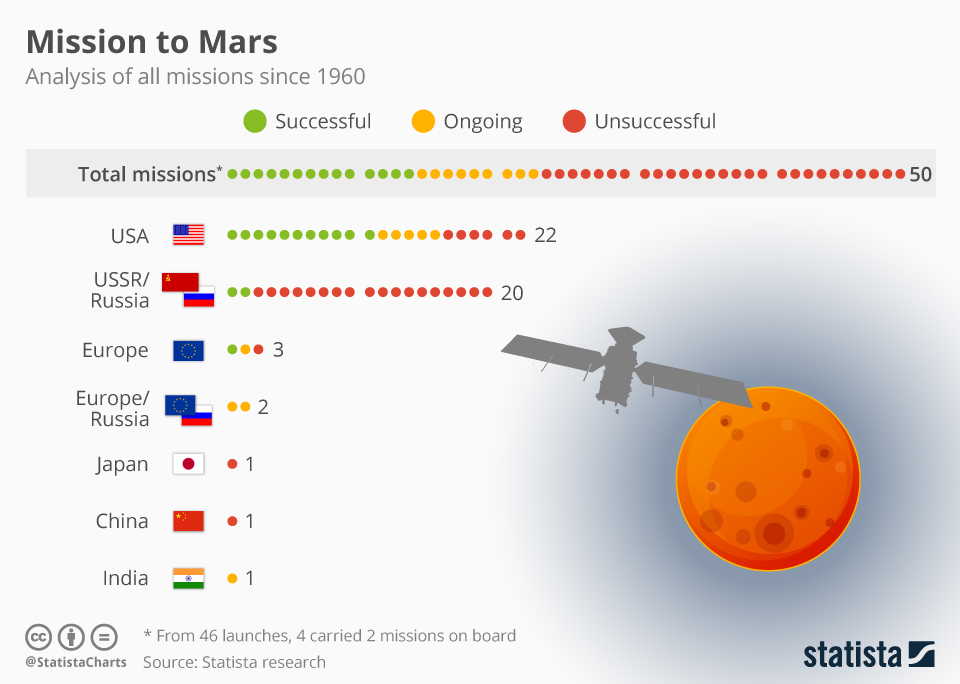
(Source: statista.com)
- Various space missions have selected Mars as a destination for research and survey because it is very close to Earth.
- Since 1950, almost 50 space missions have been launched for Mars, though just about 50% of them have been successful.
- NASA’s Mariner 9 stepped into Mars’ orbit in 1971, becoming the first spacecraft to orbit another planet.
- Mariner 9 covered 85% of the Martian surface and also shared more than 7,000 images with Earth.
- Soviet Union’s Mars 2, launched in the same year as Mariner 9, was the first human-made object to reach the Martian surface. Unfortunately, the speed of Mars 2’s approach to the planet was very high, and the ancestry system malfunctioned, causing the spacecraft to crash on the surface of Mars.
- NASA’s Viking 1 was the first spacecraft to successfully land on the surface of Mars and share about 57,000 images during its operation from 1976 to 1982.
- In 1997, NASA’s Sojourner was part of the Pathfinder mission and the first rover to operate on a different planet. It operated for 83 sols, made scientific measurements, and took many pictures.
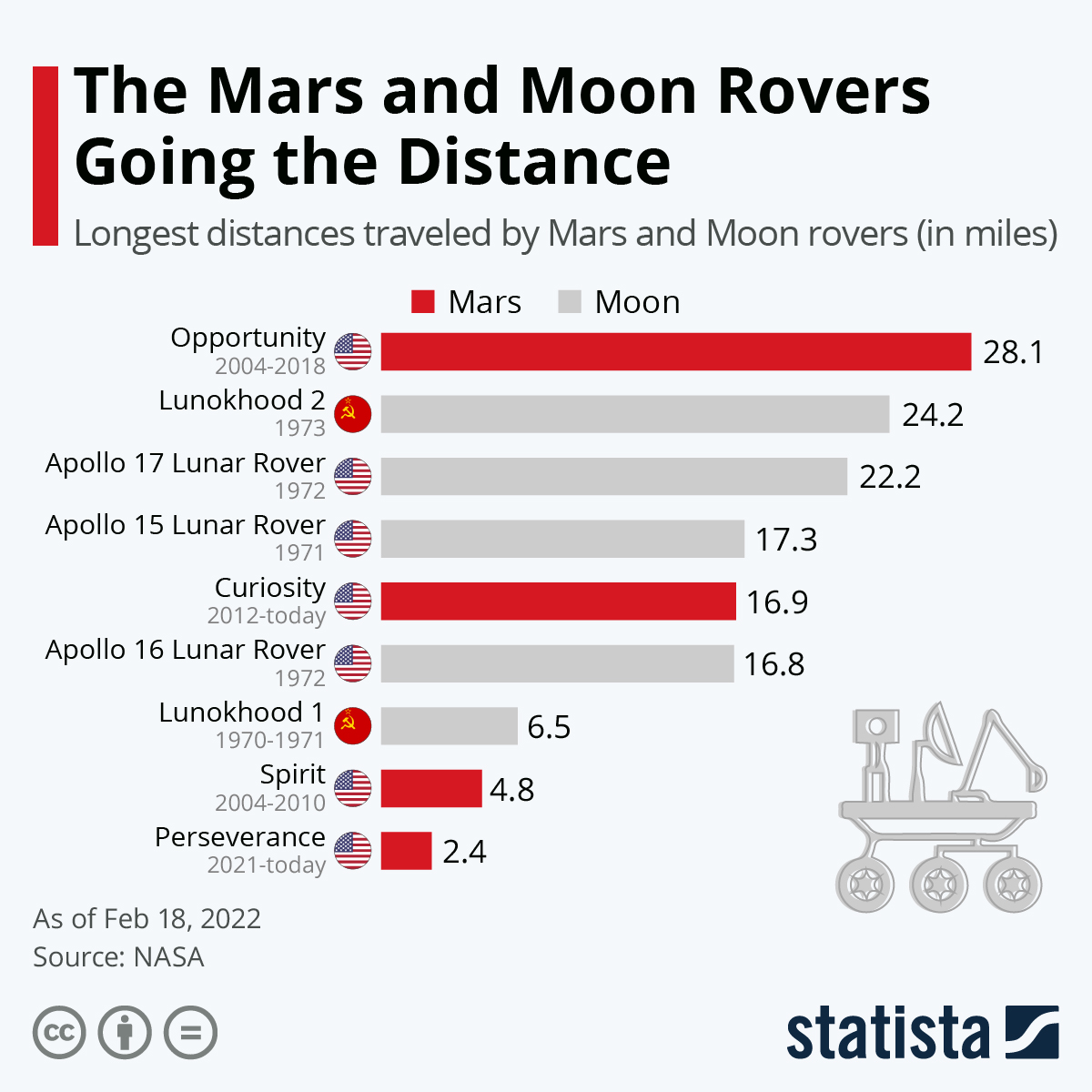
(Source: statista.com)
- In the above statistics chart, we can see the Mars and Moon Rovers going the distance in miles.
- Spirit and Opportunity were the twin rovers sent by NASA in 2004 that successfully landed on the Red Planet. These rovers were sent to study and examine Mars’s climate history and look for evidence of water activity.
- NASA’s rover, Curiosity, arrived at the Gale Crater on the Red Planet in 2012. This rover was sent to investigate the Martian atmosphere and geology, and found that the planet once had the possibility of having microbial life. This rover has been in operation for almost three thousand years and successfully landed the very first, named, which was part of the Tianwen-1 mission in 2021.
- India is getting prepared to launch a family of seemingly sci-fi robots to Mars very shortly in late 2024 on Mars.
- Perseverance has effortlessly landed on Mars’s surface on 18th February 2021 at 8.55 pm GMT in the United Kingdom.
Mars Atmosphere Magnetosphere and Moon Status
- The climate of Mars consists of almost 95% carbon dioxide, which is very similar to the climate of Venus, which is 97% carbon dioxide.
- Mars’s temperature never exceeds 20 degrees C. The temperature variation is due to the density of the two climates.
- The climate on Mars is very thin. According to a survey of scientists, this may have been caused by the loss of any liquid water on the planet.
- Spacecraft orbiting Mars have observed frozen water in its polar caps, and there is some proof that liquid water may be on the planet’s surface.
- Mars’s temperature can reach as high as 70 degrees F/ 20 degrees C and as low as -225 degrees F/ -153 degrees Celsius.
- The atmosphere is so thin that any heat coming from the sun’s rays can escape the planet.
- Mars is so windy that dust storms can cover almost the whole planet, and these winds are so strong that it can take months for the dust to settle.
- According to Mars Statistics, there are regions of the Martian crust in the southernmost hemisphere that are highly magnetized. This shows that there is evidence of a magnetic field that existed almost 4 billion years ago.
- Mars has two small moons, Deimos and Phobos. It is estimated that asteroids captured these moons.
- The two moons are seen like potatoes and have such small masses that their gravity cannot make them spherical like the moon of Earth.
- The moons of Mars are named for the horses that pulled the chariots for Ares, a Greek god of war. Phobos means flight, and Deimos means fear.
- Phobos is the “biggest “moon, and it is very close to Mars and has many deep surface grooves.
- Phobos is very slowly moving towards Mars, and it is expected that in almost 50 million years, it will break or crash into Mars.
- Deimos is 50% the size of Phobos, and its orbit is 2.5 times farther away. It is shaped very strangely and covered in loose dirt that often fills in the craters on its surface.
- Because of the odd situation, Deimons is generally smoother than Phobos.
- Mars does not have a ring, as it is thought that in almost 50 million years, Phobos will either break or crash into Mars.
Mars Meteorite Craters Statistics
- After the planets formed, they all went through a period called the “Late Heavy Bombardment” (LHB). “In particular, has visible scars from this era, with around 60% of its surface showing impact marks.
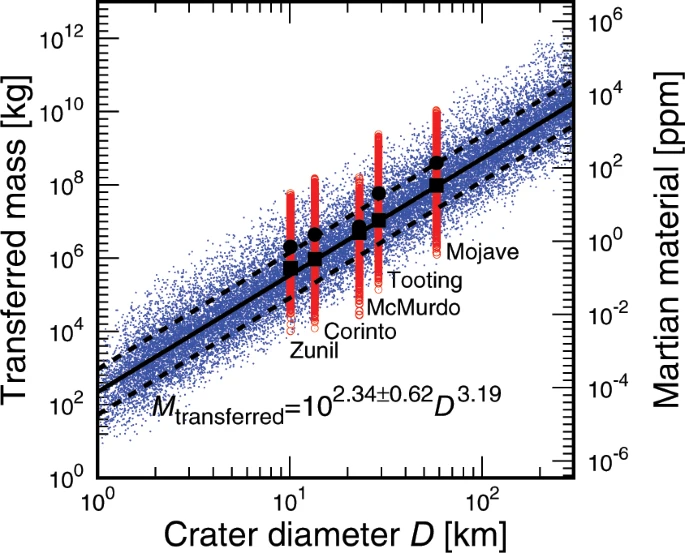 (Source: nature.com)
(Source: nature.com)
- There are about 43,000 craters on Mars that are at least 5 kilometers (3.1 miles) wide. The largest of these is the Hellas impact basin, which can be seen from Earth.
- Mars has a smaller mass than Earth, so the chances of an object hitting Mars are about half of those for Earth. However, because Mars is closer to the asteroid belt, it is more likely to be struck by materials from there.
- Additionally, Mars is more likely to be hit by short-period comets that orbit within Jupiter’s path. Despite this, Mars has fewer craters than the Moon. This is because Mars’ atmosphere protects it from smaller meteors.
- Some meteors hit Mars so hard that pieces of the planet break off and fly into space. Some of these fragments eventually reach Earth.
- Scientists have found rocks on Earth that have the same chemical makeup as Martian rocks. These rocks also show signs of having traveled quickly through the atmosphere, supporting the idea that they came from Mars.
- NASA has a catalog of 34 meteorites that are confirmed to have originated from Mars. These meteorites are incredibly valuable, as they are the only physical samples of Mars available on Earth.
- Research at NASA’s Johnson Space Center has discovered that at least three of these Martian meteorites contain possible evidence of past life.
- These meteorites have microscopic structures that look like fossilized bacteria, known as biomorphs. While the scientific analysis of these rocks is accurate and detailed, the exact cause of these structures still needs to be determined.
- The 34 Martian meteorites cataloged by NASA are highly prized assets. Their rarity and the unique information they provide about Mars make them extremely valuable.
- These meteorites are not only of scientific interest but also hold significant market value for collectors and researchers.
- The potential evidence of past life in some Martian meteorites opens up exciting possibilities for further research and exploration.
- If these findings are confirmed, they could have profound implications for our understanding of life beyond Earth. This could drive increased investment in space research and related industries.
- The fact that Mars has fewer craters than the Moon due to its atmosphere highlights the importance of planetary protection.
- The Martian meteorites are invaluable for both scientific discovery and commercial investment. Their potential evidence of past life on Mars makes them even more intriguing.
- With ongoing research and exploration, these meteorites will continue to provide insights into Mars’ history and its potential for supporting life.
Chemical Elements on Mars
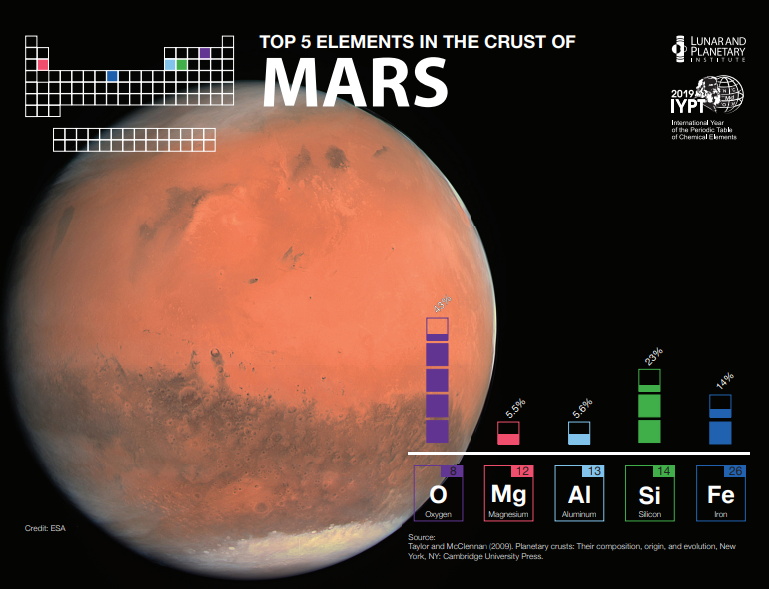
(Source: lpi.usra.edu)
- In the above chart, we can see the essential chemical elements of Mars.
- The major chemical elements on Mars’s surface are 43% oxygen, 5.5% magnesium, 5.6% aluminum, 23% silicon, and 14% iron.
Conclusion
As human beings, our enthusiasm for space and what is beyond the stars has never been lacking. Whereas a physical journey to Mars is currently far off in the future, knowing our cosmic neighbor through facts and information can bring us much closer to it. Many studies have been done to determine how human missions to Mars may be implemented. Currently, many nations are making efforts to investigate Mars and its atmosphere. This article sheds light on the statistics on Mars.
Sources

Barry is a technology enthusiast with a passion for in-depth research on various technological topics. He meticulously gathers comprehensive statistics and facts to assist users. Barry's primary interest lies in understanding the intricacies of software and creating content that highlights its value. When not evaluating applications or programs, Barry enjoys experimenting with new healthy recipes, practicing yoga, meditating, or taking nature walks with his child.









